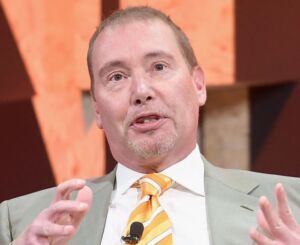When 2-year and 10-year yields invert, ‘you’re supposed to be on recession watch, and we are,’ says DoubleLine chief
A “calamity” may be coming for markets, potentially in 2023, Jeffrey Gundlach, chief executive officer, and chief investment officer of DoubleLine, warned Tuesday on stage at the Exchange ETF conference in Miami.
The Treasury market’s yield curve is signaling “trouble ahead,” Gundlach said, referring to the recent inversion of 2-year BX:TMUBMUSD02Y and 10-year yields BX:TMUBMUSD10Y, which historically has preceded a recession. The setup in the stock market is “very similar” to the one seen in the fourth quarter in 1999, he warned, in a reference to the lead-up to the bursting of the dot-com bubble.
The S&P 500 has been “massively juiced” by quantitative easing and low rates under central banking policy, according to Gundlach, who said that he favors stocks outside the U.S. “One of the hardest things” in the investment business is “to change after you’ve been right,” he said.
While the S&P 500 saw an unusually strong run over the past few years, it’s down so far in 2022 amid heightened concern over the Russia-Ukraine war and expectations for the Federal Reserve to battle soaring inflation in part through interest rate hikes. Gundlach said he expects that European stocks will outperform the U.S., particularly when a recession arrives.
When 2-year and 10-year yields invert, “you’re supposed to be on recession watch, and we are,” said Gundlach, who is known as the bond king. “I am not looking for a recession this year because it takes time.”
The yield on the 2-year Treasury note briefly exceeded the 10-year yield recently. A persistent inversion of that measure of the curve has been a reliable predictor of recession, though typically with a lag of more than a year.
The fact that 10-year yields have moved back above 2-year yields “is not a cause for celebration if you’re looking for economic growth,” said Gundlach, who also sees the disinversion as a cause for concern.
Meanwhile, the cost of living is “much higher” than the rise captured by the consumer-price index, according to Gundlach, who said wage growth and rising rents will be important drivers of inflation this year.
The consumer-price index jumped 1.2% in March, fueled by the higher cost of gasoline, food, and housing, according to a statement Tuesday from the U.S. Bureau of Labor Statistics. It was the largest monthly gain since Hurricane Katrina in 2005, driving inflation over the past year to 8.5% — the highest since January 1982.
But core inflation, which excludes food and energy, rose just 0.3% in March for the smallest increase in six months and a potential sign that the surging cost of living may be peaking.
“We think inflation is going to fall ”this year, said Gundlach, but remain elevated. He predicted that it will probably fall to around 6%.
Gundlach also lamented a rough 2022 for fixed income so far. With some core bond funds being down 12% this year, “we’re talking about a massive bear market,” he said. “Who wants to be ‘bond king’ these days?”
Major U.S. stock benchmarks were up Tuesday afternoon, with the S&P 500 SPX rising about 0.5% , the Dow Jones Jones Industrial Average DJIA gaining 0.3% and the Nasdaq Composite COMP climbing 0.7%, according to FactSet data, at last check.
Within fixed income, the yield on the 10-year Treasury note was down about 9 basis points at around 2.68% Tuesday afternoon, FactSet show. The 2-year yield was trading below that level, at about 2.38%.

